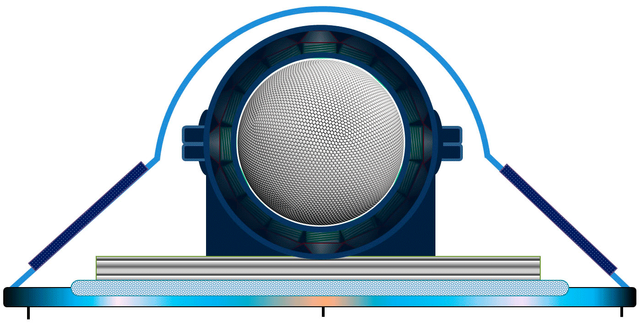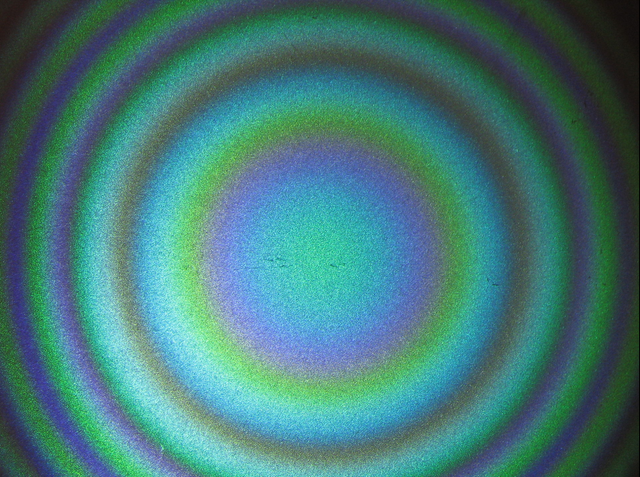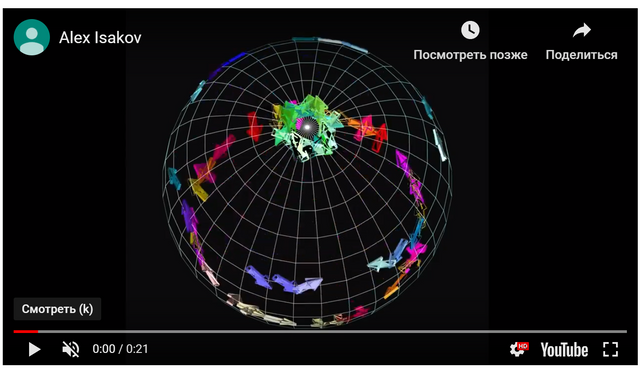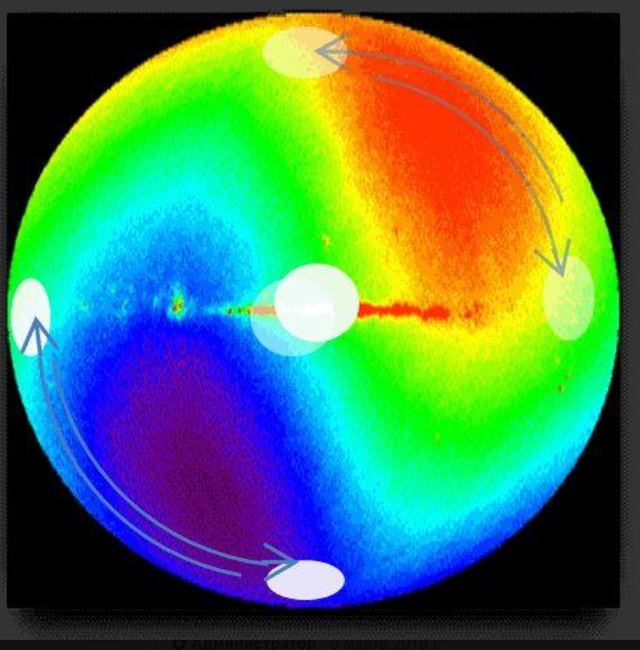Artificial coherent oscillations of matter
It all started with the question: is it possible to create coherent oscillations of matter? For example, to rotate a spherical solid-state rotor of a gyroscope in a certain way in an evacuated stator cavity around three axes per cycle, and not around one? And it turned out that yes, we can create such a device - a spherical synchronous machine controlled by a computer, in which the solid-state rotor produces forced coherent oscillations with a constant phase difference from three artificial sources.
The concept of coherence formed at the beginning of the XIX century after the experiments of the English scientist Thomas Jung. In them, two light waves from different sources fell on the projection screen and folded ... .
Consider the light from two ordinary incandescent bulbs, which give incoherent radiation to the projection screen. This light is folded simply: the screen illumination is equal to the sum of the illumination from each lamp. For light waves from light bulbs, the phase difference varies randomly over time. For example, if two wave maxima have now arrived at one point on the screen, then at the next moment there can be a minimum from one lamp, and a maximum from another. The result of the addition of waves will give "ripples on the water" - an unstable (moving), very rapidly changing interference pattern. The ripples of light waves are so fast that the eyes do not have time for it and see a uniformly lit screen. If we consider an analogy from the world of sounds - it looks like white noise.
However, the result will be quite different if two coherent waves are to the screen. In the analogy with sound, if sinusoidal oscillations from one generator are fed into the sound channels of a stereo speaker system and the relative phases of oscillations in one channel are slowly changed, you can hear the imaginary sound source moving from one speaker to another. For light, such waves are easiest to obtain from a single laser beam, splitting it into two parts, and then adding them together. Then, when the intensities are added, stripes will appear on the screen. Bright are areas of the screen where light wave maxima always arrive at the same time (in phase). The remarkable optical effect is that the illumination will not increase twice, as in the case of incoherent waves, but four. This happens because in the bright band all the time the maxima of the waves add up, and with a constant phase difference, that is, their amplitudes and the illumination is proportional to the square of the sum of the amplitudes of the waves. In dim bands, coherent waves from different sources dampen each other on the screen.
Thus, each part of a substance can exhibit the properties of a wave. Such waves are called matter waves or de Broglie waves. In 1923, the remarkable French physicist Louis de Broglie proposed a very simple formula that relates a long wave (the distance between the maxima) to the mass of particles m and its velocity v: λ = h/mv, h — where h is Planck's constant.
The fundamental property of waves of any nature is the ability to produce an interference pattern. However, in order to obtain a fixed interference pattern, as is the case with light, a bright band, it is necessary to ensure the coherence of de Broglie waves. This is prevented by the thermal motion of elements of mass, which differ in their wavelengths with different speeds. When cooling the elements of mass, according to the de Broglie formula, the wavelength λ increases. And as soon as its value exceeds the distance between the particles, de Broglie waves of different particles will give a stable interference pattern, since the maxima of the waves corresponding to the position of the particles will overlap.
In order to create coherent oscillations of particles (of which the rotor of an unusual gyroscope consists) at higher temperatures, it is possible to create coherent oscillations of the spherical rotor itself. And we will not project the light onto the screen, but this being the invisible interference pattern from the accelerations of the rotor mass elements.
We begin by defining the coherent oscillation of the rotor of an unusual gyroscope.
“The motion of a physical body, in which the only one of its points O remains fixed at all times, is called motion (rotation) of a solid body around a fixed point O. In this case, all points of the physical body move along the surfaces of concentric spheres whose centers are at point O. Therefore such a motion is called the spherical motion of the body. Based on the definition of spherical motion, we obtain the parametric equations of the forced coherent oscillation of the rotor mass elements.
"The coherent oscillations of the elements of mass are spherical motion of a physical body, the forced total harmonic oscillations of which are successively performed by triads (alternately for equal and short time intervals) from angular displacements of any points at the intersection of axes, fixed Cartesian coordinates with surfaces of concentric spheres according to laws cosine and \ or sinus ".
θx = sin(θ)
θy = -sin(θ)
θz = cos(θ).
Where angles: θx - roll; θy - pitch; θz- yaw. Parameters θ = πt and -1 ≤ t ≤ 1; where θ is the geometric angle, measured from the arbitrary direction of a clockwise direction, from the corresponding semi-axis, and t specifies the required accuracy of the angular turns. The motion formula is set parametrically and is applicable for any radius. When Δt → 0 we have a small angle.
The small-angle approximation is a useful simplification of the basic trigonometric functions, which is approximately true in the limit when the angle tends to zero. These are truncations of the Taylor series for basic trigonometric functions in the second order approximation.
sin(θ)≅ θ
According to the Holographic Principle: "In the limit of a very large region, the boundary surface can be considered a flat plane at infinity." Thus
sin(θ) = θ.
This formula for coherent oscillations of the rotor mass elements of an unusual gyroscope simply shows how an isolated (idealized) classical and simultaneously quantum system can behave in statistics with minimal impact on the system. If we load all 64 directions of such coherent oscillations into a computer simulator — a program for visualizing the dynamics in isometry, we will be able to observe the properties and, very importantly, the statistical dynamics of all the elementary particles of the Standard Model. In a computer simulator, we see how two projections of each elementary particle appear, how projection centers behave — elementary particles, how they exchange energy, momentum and interact, and how they are connected to each other to form larger structures of three generations.
For the rotor mass elements of an unusual gyroscope, by analogy with the interference of light, we need to get a “bright point on the screen” - a small area on the surface where the maxima of matter accelerations are in phase. Unexpectedly, the coherent waves of many and many mass elements can occupy one region in space, forming a sort of supplement — a set of a huge number of de Broglie waves. In the language of quantum mechanics, this means that the probability of detecting coherent mass elements at the “bright point” is maximum. This amazing state of matter is called the Bose-Einstein condensate. Albert Einstein predicted it in 1925 based on the work of the Indian physicist Shatendranath Bose. In condensate, all elements of the mass are in the same quantum state and behave like one big wave. For elements of the mass of a coherently oscillating rotor of an unusual gyroscope, the rotor speed changes direction six times, which means that the first derivative of the speed — the acceleration vanishes six times at equal intervals of the cycle. Thus, we have six identical but diametrically directed groups of accelerations that can be projected without losses “from the inside” and moved along the holographic screen of the Universe without losses. But now, this fixed interference pattern of the six groups of accelerations of the elements of mass can be viewed in thermodynamics not on the screen, since, according to the Holographic Principle, accelerations are directly related to the entropy gradients on the screen.
ΔS ∼ α
The projections of these accelerations as white circles are shown against the global temperature anisotropy of the holographic screen of the Universe.
Moving four of the six groups of accelerations of the rotor mass elements against the background of the global temperature gradient on the holographic screen, we generate an entropy (gravitational) force acting at a distance and applied to the rotor center of mass.
F = ΔTΔS, is a universal law for all forces and interactions in our Universe. F - is an entropic super force that acts on its holographic inflation surface - a 2D screen as a result of moving information/entropy along it. ΔT- is the temperature gradient, ΔS - is the entropy gradient caused by the acceleration of matter.
For gravity:
Thermodynamic parameters: Fg - is the directed gravitational force, ΔT - is the (global) temperature gradient on the holographic horizon of the Universe, ΔS - is the entropy gradient caused by the acceleration of matter.
Fg = ΔTΔS.
Thus, it is possible to create a series of gravitational forces and control gravity, get a tandem of a computer simulator and an unusual gyroscope - a real device for scientific visualization of these quantum processes - a fundamentally new and inexpensive tool for research in the field of quantum physics and cosmology at the "apple" level, working on uniform formula.
Details on my site: www.isan.com.ua

Now very short:
This device is a fundamentally new type of power gyro with a coherently oscillating rotor. Coherent oscillations create an interference pattern from the accelerations of the rotor mass elements. More precisely, six identical and diametrically located groups of the interference pattern of accelerations of the rotor mass elements. A computer program can change these four of the six groups in places, which leads to the emergence of a directed gravitational force applied to the center of mass of the rotor. We have all 64 directions. Coherence and the interference pattern are all properties of holograms, hence a connection with the well-known theory - the Holographic Principle, the conclusions of which confirm that we are on the right path. But the most important thing is the opportunity to receive double recovery energy. The zero-point energy is converted in the inductors and exactly twice the amount of energy spent on the coherent oscillations of the rotor. And that is not all. In addition to controlling gravity and obtaining vacuum energy converted into electrical energy, we are able to bypass restrictions on the transmission and reception of information without limiting the distance and speed of light. Unfortunately, the scientific community is in a state of shock and simply ignores these seemingly speculative statements. Maybe soon it will pass and an unusual gyroscope will be prototyped, at least because before us is a fundamentally new type of power gyro with new properties.



Congratulations @alexisakov! You have completed the following achievement on the Steem blockchain and have been rewarded with new badge(s) :
Click here to view your Board
If you no longer want to receive notifications, reply to this comment with the word
STOPHello @alexisakov! This is a friendly reminder that you have 3000 Partiko Points unclaimed in your Partiko account!
Partiko is a fast and beautiful mobile app for Steem, and it’s the most popular Steem mobile app out there! Download Partiko using the link below and login using SteemConnect to claim your 3000 Partiko points! You can easily convert them into Steem token!
https://partiko.app/referral/partiko
Congratulations @alexisakov! You received a personal award!
Click here to view your Board
Vote for @Steemitboard as a witness and get one more award and increased upvotes!